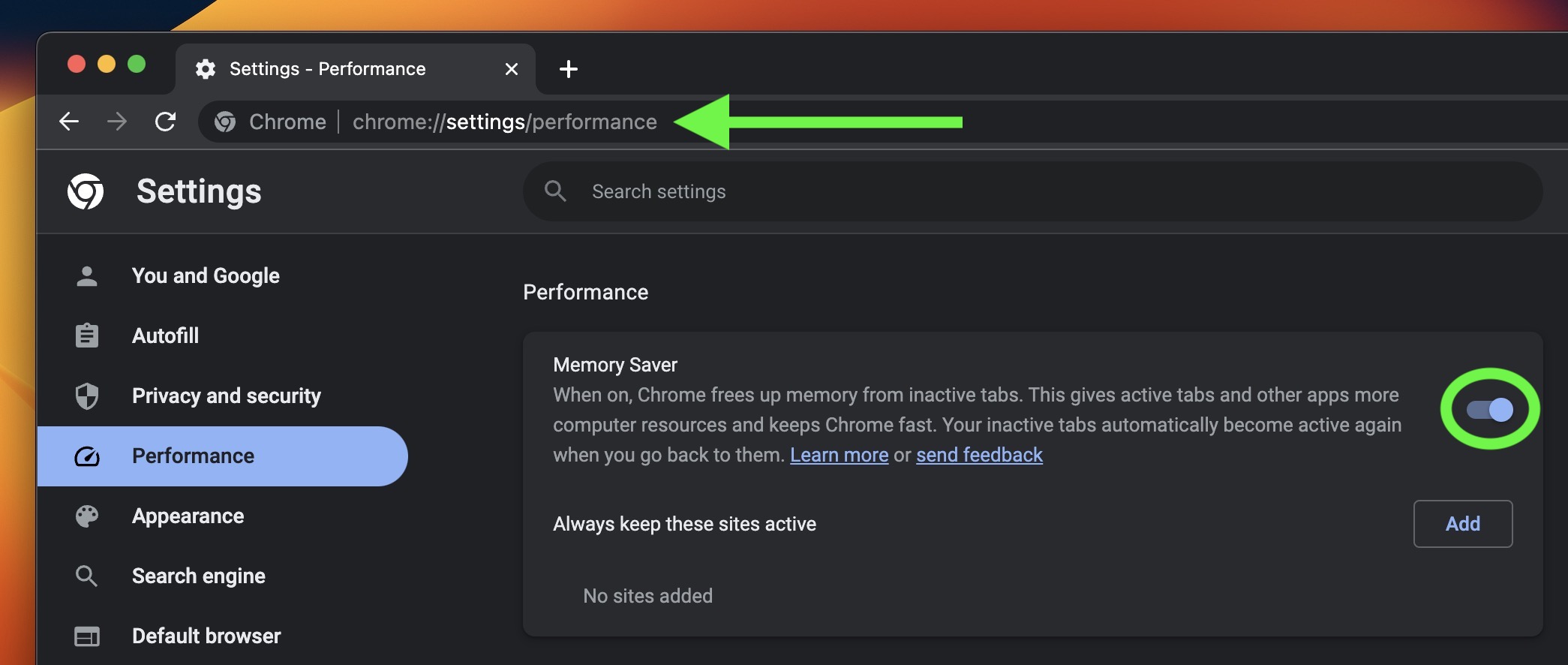Introduction
Chrome is undoubtedly one of the most popular web browsers, known for its speed, versatility, and user-friendly interface. However, as you continue to use Chrome and open multiple tabs, you may notice that it starts consuming a significant amount of memory. This can lead to sluggish performance, slow loading times, and even system crashes, especially on devices with limited RAM.
The good news is that there are several effective strategies to reduce memory usage in Chrome, allowing you to enjoy a smoother browsing experience without compromising on functionality. By implementing these techniques, you can optimize Chrome's performance and make the most of its impressive features while minimizing its impact on your device's resources.
In the following sections, we will explore practical tips and tricks to help you address memory usage issues in Chrome. From leveraging Chrome's built-in tools to making strategic adjustments to your browsing habits, you'll discover actionable steps to streamline Chrome's performance and enhance your overall browsing experience. Whether you're a casual user or a power user who relies on Chrome for work and leisure, these strategies are designed to help you maximize the browser's efficiency and minimize memory-related challenges.
So, if you've ever found yourself frustrated by Chrome's memory-hungry behavior, fear not. With the right approach and a bit of know-how, you can take control of Chrome's memory usage and enjoy a more responsive and enjoyable browsing experience. Let's dive into the practical solutions that will empower you to optimize Chrome's performance and make the most of this popular web browser.
Use Chrome's Task Manager
One of the most effective ways to gain insight into Chrome's memory usage and address potential issues is by utilizing Chrome's built-in Task Manager. Similar to the operating system's task manager, this feature provides a detailed overview of each tab, extension, and process running within the browser, along with their respective memory and CPU usage.
To access Chrome's Task Manager, simply click on the three-dot menu in the top-right corner of the browser window, navigate to "More tools," and select "Task Manager." Alternatively, you can use the keyboard shortcut Shift + Esc to open the Task Manager directly.
Once inside the Task Manager, you'll be presented with a comprehensive list of all active tabs, extensions, and processes, along with their memory and CPU consumption. This real-time data allows you to identify any resource-intensive elements within Chrome, enabling you to pinpoint and address memory-hungry tabs or extensions that may be contributing to excessive memory usage.
By leveraging the Task Manager, you can make informed decisions about which tabs or extensions to close or disable, thereby freeing up memory and optimizing Chrome's performance. Additionally, you can use this tool to identify and terminate unresponsive or problematic processes, which can help prevent memory leaks and improve overall stability.
Furthermore, the Task Manager empowers you to monitor the impact of your browsing habits on memory usage, providing valuable insights that can guide you in adopting more efficient practices. Whether you're a heavy multitasker with numerous tabs open simultaneously or a user who relies on various extensions, the Task Manager offers a transparent view of how these elements affect Chrome's memory footprint.
In essence, Chrome's Task Manager serves as a powerful diagnostic tool, allowing you to take proactive measures to manage memory usage effectively. By regularly monitoring and optimizing the browser's resources using this feature, you can enhance Chrome's responsiveness, reduce memory-related issues, and enjoy a smoother browsing experience overall.
Disable or Remove Extensions
Extensions are a key feature of Chrome, offering additional functionality and customization options to enhance your browsing experience. However, it's important to recognize that each installed extension consumes memory and processing power, potentially contributing to Chrome's overall memory usage. Therefore, evaluating and managing your extensions is crucial in optimizing the browser's performance.
To begin, it's advisable to review the extensions you have installed and assess their utility. Navigate to the Chrome menu, select "More tools," and then click on "Extensions." Here, you'll find a list of all installed extensions, along with options to disable or remove them.
When evaluating extensions, consider their relevance to your daily browsing activities. Are there extensions that you rarely use or that no longer serve a purpose? If so, disabling or removing them can free up valuable memory and streamline Chrome's operation. Additionally, some extensions may be resource-intensive, particularly those that constantly run in the background or interact with multiple web pages simultaneously. By identifying and disabling such extensions, you can significantly reduce Chrome's memory footprint.
It's worth noting that certain extensions may exhibit memory leaks or compatibility issues, leading to increased memory usage over time. By disabling or removing problematic extensions, you can mitigate these issues and create a more stable browsing environment. Furthermore, regularly reviewing and optimizing your extensions can help prevent conflicts and improve overall browser performance.
In some cases, you may find that a single extension is responsible for a disproportionate amount of memory consumption. In such instances, consider whether the benefits of the extension outweigh its impact on Chrome's performance. If not, removing the extension can lead to noticeable improvements in memory usage and responsiveness.
By taking a proactive approach to managing your extensions, you can tailor Chrome to better suit your needs while minimizing its memory demands. Whether it involves decluttering unnecessary extensions, addressing resource-intensive add-ons, or troubleshooting compatibility issues, optimizing your extension usage can have a tangible impact on Chrome's memory efficiency.
In essence, by carefully evaluating and selectively disabling or removing extensions, you can effectively reduce Chrome's memory usage, leading to a more streamlined and responsive browsing experience.
Enable Click-to-Play Plugins
Enabling click-to-play plugins in Chrome can significantly contribute to reducing memory usage and enhancing overall browsing performance. By default, web browsers like Chrome often automatically load and run various plugins, such as Adobe Flash and Java, when you visit web pages that require them. However, this can lead to increased memory consumption, especially if multiple tabs with resource-intensive plugins are open simultaneously.
Click-to-play plugins offer a solution to this issue by requiring user interaction before activating plugins on a web page. When this feature is enabled, plugins remain inactive until you explicitly choose to run them by clicking on designated placeholders within the web page. This approach not only provides greater control over plugin usage but also helps conserve memory by preventing unnecessary plugin activation.
To enable click-to-play plugins in Chrome, follow these steps:
- Open Chrome and type "chrome://settings/content" in the address bar, then press Enter.
- Scroll down to the "Plugins" section and select "Click to play."
- Once enabled, Chrome will prompt you to allow or deny plugin activation when encountering them on web pages.
By enabling click-to-play plugins, you can effectively reduce memory usage in Chrome, particularly when browsing sites that heavily rely on plugins. This feature empowers you to selectively activate plugins based on your needs, preventing excessive memory consumption from unused or unnecessary plugins running in the background.
Moreover, click-to-play plugins offer an added layer of security by requiring user consent before executing potentially vulnerable or intrusive plugins. This proactive approach not only enhances memory efficiency but also contributes to a safer and more controlled browsing environment.
In essence, by enabling click-to-play plugins in Chrome, you gain greater control over plugin activation, leading to reduced memory usage, improved browsing performance, and enhanced security. This simple yet impactful adjustment can make a noticeable difference in Chrome's memory management, ultimately contributing to a more streamlined and enjoyable browsing experience.
Use Chrome's Built-in Cleanup Tools
Chrome offers a range of built-in cleanup tools designed to help users optimize the browser's performance and manage memory usage effectively. These tools are readily accessible and provide convenient ways to clear clutter, remove unnecessary data, and enhance Chrome's overall responsiveness.
One of the primary cleanup tools available in Chrome is the built-in browsing data management feature. By accessing the Chrome settings, users can navigate to the "Privacy and security" section and select "Clear browsing data." This functionality allows for the removal of various types of data, including browsing history, cookies, cached images and files, and more. By periodically clearing this data, users can free up valuable disk space and potentially reduce memory usage, leading to improved browsing performance.
In addition to clearing browsing data, Chrome's cleanup tools also include the ability to manage and remove stored passwords, autofill form data, and site settings. By reviewing and selectively clearing this information, users can declutter their browsing environment and potentially reduce the memory footprint associated with storing and managing this data.
Furthermore, Chrome's built-in cleanup tools extend to the management of stored and cached files. Users can access the "Site settings" section within Chrome's settings to view and control permissions, notifications, and data storage for individual websites. By reviewing and adjusting these settings, users can optimize Chrome's memory usage by limiting the storage and data associated with specific sites, thereby contributing to a more efficient browsing experience.
Moreover, Chrome's cleanup tools encompass the ability to manage and remove installed web apps and extensions. By navigating to the "Extensions" and "Apps" sections within Chrome's settings, users can review and uninstall unnecessary or unused apps and extensions, reducing the overall memory overhead associated with these elements.
By leveraging Chrome's built-in cleanup tools, users can take proactive steps to declutter their browsing environment, remove unnecessary data, and optimize memory usage. This, in turn, can lead to a more responsive and efficient browsing experience, with reduced memory-related issues and improved overall performance.
In essence, Chrome's built-in cleanup tools provide valuable resources for users to manage and optimize memory usage, contributing to a more streamlined and enjoyable browsing experience. By incorporating these tools into their regular browsing routine, users can maintain a well-organized and efficient Chrome environment while minimizing memory-related challenges.
Update Chrome and Your Operating System
Regularly updating Chrome and your operating system is a fundamental yet often overlooked strategy for optimizing memory usage and enhancing overall browsing performance. Both Chrome and the underlying operating system receive periodic updates that include bug fixes, security patches, and performance enhancements, all of which can directly impact memory management and resource utilization.
When it comes to Chrome updates, Google consistently releases new versions of the browser to address known issues, improve stability, and introduce new features. These updates often include optimizations aimed at reducing memory consumption and enhancing the browser's efficiency. By keeping Chrome up to date, users can benefit from these performance improvements, leading to a more responsive and streamlined browsing experience.
Similarly, operating system updates, whether it's Windows, macOS, or Linux, play a crucial role in maintaining a healthy and efficient computing environment. These updates not only address security vulnerabilities and compatibility issues but also include optimizations that can positively impact memory management. By ensuring that your operating system is running the latest updates, you can leverage the advancements in memory management and resource allocation, contributing to improved overall system performance, including Chrome's memory usage.
Furthermore, updating both Chrome and your operating system is essential for staying ahead of potential security threats and vulnerabilities. Outdated software, including web browsers and operating systems, can be susceptible to security exploits that may impact system stability and compromise sensitive data. By staying current with updates, users can benefit from enhanced security measures that not only protect their browsing activities but also contribute to a more secure and reliable computing environment.
In essence, updating Chrome and your operating system is a proactive approach to optimizing memory usage and ensuring a smooth and secure browsing experience. By staying current with the latest software updates, users can take advantage of performance enhancements, security improvements, and memory management optimizations, ultimately leading to a more efficient and enjoyable browsing experience.
Use a Lightweight Theme
In the quest to optimize Chrome's performance and reduce memory usage, the choice of a browser theme can play a surprisingly significant role. While themes are primarily known for their aesthetic appeal, opting for a lightweight theme can contribute to a more efficient browsing experience.
Lightweight themes are designed to minimize the strain on system resources, including memory and processing power, without compromising on visual appeal. By choosing a lightweight theme, users can enjoy personalized browser aesthetics while mitigating the impact on Chrome's memory footprint.
When selecting a lightweight theme for Chrome, it's essential to consider factors such as minimalistic design, subdued animations, and streamlined visual elements. These characteristics are tailored to reduce the theme's resource demands, making it an ideal choice for users seeking to optimize memory usage without sacrificing visual customization.
In contrast to more elaborate themes that may incorporate complex animations, high-resolution graphics, and interactive elements, lightweight themes prioritize efficiency and performance. By embracing simplicity and resource-conscious design, these themes can contribute to a smoother browsing experience, particularly on devices with limited memory capacity.
Furthermore, lightweight themes can complement efforts to streamline Chrome's overall operation, aligning with the goal of reducing memory-related challenges. By minimizing the resources allocated to browser customization, users can allocate more memory to active tabs and essential processes, potentially leading to improved responsiveness and reduced memory consumption.
In essence, the choice of a lightweight theme for Chrome represents a subtle yet impactful strategy for optimizing memory usage. By embracing a theme that prioritizes efficiency and resource-conscious design, users can personalize their browsing environment while contributing to a more streamlined and memory-efficient Chrome experience.
Clear Browsing Data Regularly
Regularly clearing browsing data is a fundamental practice that can significantly impact Chrome's memory usage and overall performance. When you browse the web, Chrome accumulates various types of data, including browsing history, cookies, cached images and files, and site settings. While these data serve functional purposes, they can also contribute to increased memory consumption over time.
By accessing Chrome's built-in cleanup tools and selecting the "Clear browsing data" option, users can effectively remove accumulated data that may be unnecessary or outdated. This process not only helps free up valuable disk space but also plays a crucial role in optimizing memory usage within the browser.
Clearing browsing data serves as a proactive measure to declutter the browsing environment, reducing the memory overhead associated with storing and managing this data. By periodically removing browsing history, cookies, and cached files, users can mitigate the impact of accumulated data on Chrome's memory footprint, leading to improved responsiveness and a more efficient browsing experience.
Moreover, clearing browsing data can contribute to enhanced privacy and security. By removing stored cookies and site data, users can minimize the risk of unauthorized tracking and data retention, promoting a more secure and private browsing environment.
In addition to the direct impact on memory usage, regularly clearing browsing data can also lead to improved browsing performance. By reducing the burden of managing extensive data, Chrome can allocate resources more efficiently, potentially resulting in faster page loading times and smoother navigation.
Overall, the practice of clearing browsing data regularly is a simple yet effective strategy for optimizing memory usage in Chrome. By incorporating this routine into your browsing habits, you can maintain a lean and efficient browsing environment, leading to improved memory management and a more responsive browsing experience.
Use a Content Blocker Extension
Integrating a content blocker extension into your Chrome browser can be a game-changer when it comes to optimizing memory usage and enhancing your overall browsing experience. Content blockers are designed to selectively prevent the loading of specific types of content on web pages, such as advertisements, tracking scripts, and other resource-intensive elements. By leveraging a content blocker extension, you can effectively reduce the strain on your system resources, including memory and CPU usage, while enjoying a cleaner and more streamlined browsing environment.
One of the primary benefits of using a content blocker extension is its ability to minimize the impact of resource-heavy elements commonly found on websites. Advertisements, in particular, are known to consume significant memory and processing power, often leading to slower page loading times and increased memory usage. By selectively blocking these ads, as well as other non-essential content such as tracking scripts and social media widgets, a content blocker extension can help alleviate the memory burden on your browser, leading to improved performance and responsiveness.
Furthermore, content blockers contribute to a more focused and distraction-free browsing experience. By removing intrusive and irrelevant content from web pages, users can enjoy a cleaner and more visually appealing interface, free from the clutter of excessive advertisements and tracking elements. This not only enhances the overall aesthetics of web pages but also reduces the cognitive load on users, leading to a more enjoyable and efficient browsing experience.
In addition to optimizing memory usage, content blockers can also enhance privacy and security. By preventing the loading of tracking scripts and potentially malicious content, these extensions contribute to a more secure browsing environment, protecting users from unwanted tracking and potential security threats. This proactive approach to content management aligns with the goal of creating a safer and more controlled browsing experience, further enhancing the value of integrating a content blocker extension into Chrome.
In essence, by incorporating a content blocker extension into your browsing toolkit, you can effectively reduce memory usage, enhance browsing performance, and enjoy a more secure and streamlined online experience. This strategic addition to your browser environment empowers you to take control of the content you encounter while optimizing memory usage, ultimately leading to a more efficient and enjoyable browsing experience.
Consider Using a Different Browser
If you've exhausted all available options to optimize memory usage in Chrome and continue to encounter persistent performance issues, it may be worthwhile to consider using a different browser. While Chrome is renowned for its speed and versatility, alternative browsers offer unique features and performance optimizations that may better suit your browsing needs.
One compelling alternative is Mozilla Firefox, a popular open-source browser known for its emphasis on privacy, customization, and efficient memory management. Firefox's Quantum engine is designed to deliver a fast and responsive browsing experience while effectively managing memory usage, making it a viable option for users seeking a more streamlined and efficient browser environment.
Another noteworthy contender is Microsoft Edge, which has undergone significant improvements in recent years, particularly with the transition to the Chromium-based engine. This shift has not only enhanced compatibility and performance but also contributed to more efficient memory utilization, resulting in a smoother and more responsive browsing experience.
For users who prioritize privacy and security, the Tor Browser presents a compelling choice. Built on the foundation of the Tor network, this browser prioritizes anonymity and privacy, offering robust memory management capabilities that cater to users seeking a secure and discreet browsing experience.
Additionally, Opera, with its built-in ad blocker and resource-saving features, provides an alternative that focuses on optimizing memory usage and delivering a fast, efficient browsing experience. Its innovative features, such as the integrated VPN and battery saver mode, further contribute to a well-rounded browsing solution that prioritizes performance and resource efficiency.
By exploring alternative browsers, you can leverage a diverse range of features and optimizations that may better align with your specific preferences and requirements. Whether it's a focus on privacy, performance, or resource management, the variety of available browsers ensures that you can find a solution tailored to your individual needs, potentially leading to a more satisfying and efficient browsing experience.

























